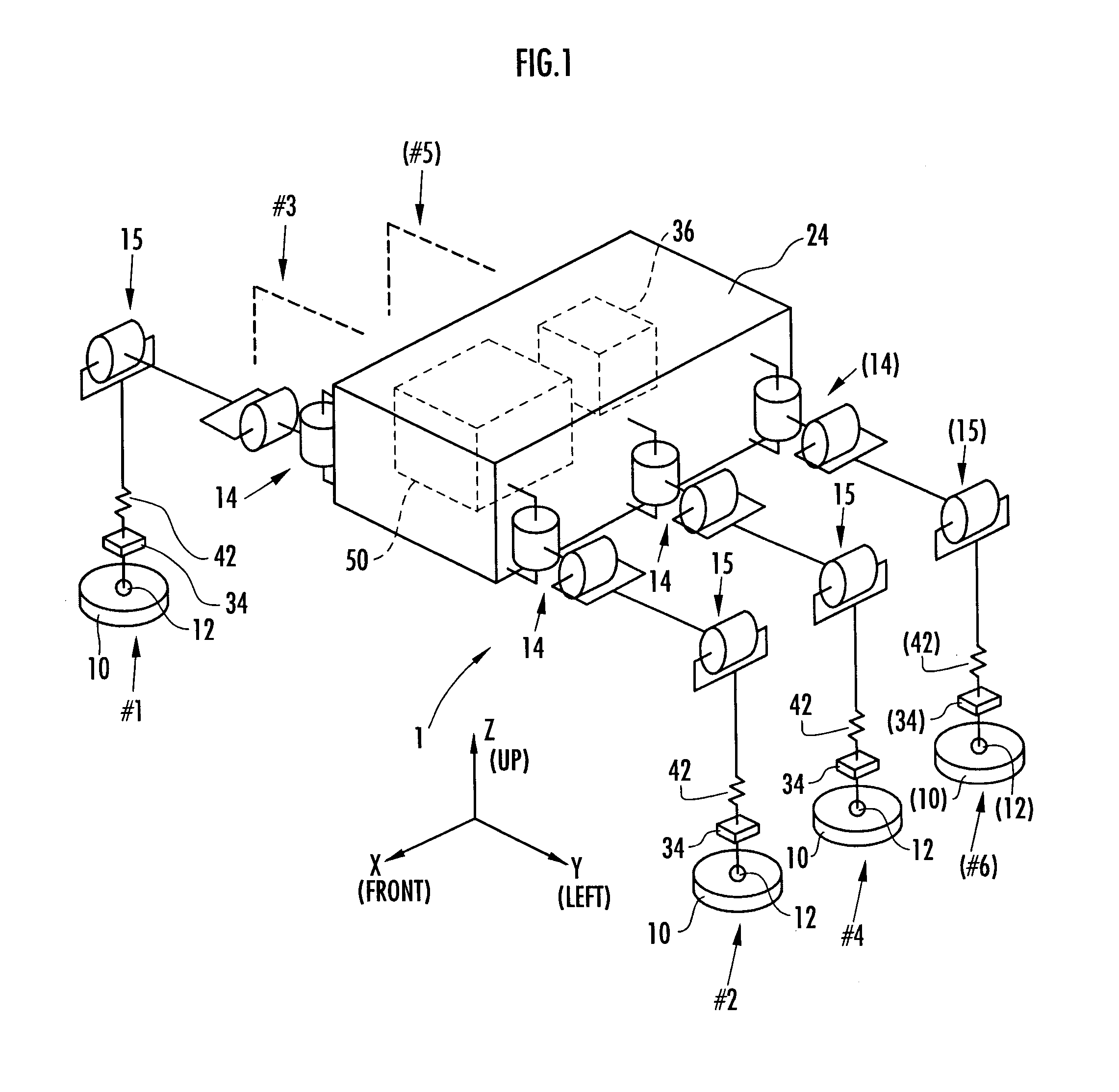Control device for mobile body
a control device and mobile robot technology, applied in the direction of electric programme control, program control, instruments, etc., can solve the problems of unstable contact condition of the portion coming into contact, inability to control external forces acting on the knees, floor reaction forces, etc., and achieve the effect of stabilizing the posture of the robo
- Summary
- Abstract
- Description
- Claims
- Application Information
AI Technical Summary
Benefits of technology
Problems solved by technology
Method used
Image
Examples
first reference example
[0078]FIG. 1 is an external view of a general multi-legged mobile robot (legged mobile robot) according to first and second reference examples. FIG. 1 shows that the robot 1 has six legs (leg bodies), namely, a first leg #1 to a sixth leg #6; however, it does not have the fifth leg #5 and the sixth leg #6 in the first reference example. This means that, in the first reference example, the robot 1 is a four-legged robot having four legs (leg bodies), the first leg #1 to the fourth leg #4. In FIG. 1, the components of the robot 1 according to the second reference example are shown by parenthesized reference numerals.
[0079] As shown in FIG. 1, in the robot 1 (the four-legged robot) according to the first reference example, two legs (the first leg #1 and the third leg #3) are extended from the right side of a body 24, which is the base body of the robot 1, such that they are arranged side by side in the longitudinal direction, and in the same manner, two legs (the second leg #2 and the...
second reference example
[0280] The following will explain a second reference example of the present invention with reference to the aforesaid FIG. 1 and FIG. 24 to FIG. 34. Referring to FIG. 1, the explanation will be focused on the aspects of a robot 1 of the second reference example that are different from the robot of the first reference example. The robot 1 of the second reference example is provided with, in addition to the first to the fourth legs #1 to #4, a fifth leg #5 and a sixth leg #6 having the same structures as those of the legs #1 to #4. This means that the robot 1 of the second reference example is a six-legged robot. The fifth leg #5 is behind the third leg #3 and extended from the right side of the body 24 of the robot 1, and the sixth leg #6 is behind the fourth leg #4 and extended from the left side of the body 24 of the robot 1. The rest of the mechanical structure of the robot 1 is the same as that of the first reference example, so that the like reference numerals as those of the fi...
third reference example
[0339] An explanation will now be given of a third reference example in which a floor configuration estimating function and a function for correcting the operation of the robot 1 on the basis of the result of the estimation have been added to the robot 1 (six-legged robot) of the second reference example. In the present reference example, the explanation will be focused mainly on the six-legged robot shown in the second reference example; however, supplemental explanation will be added also to a four-legged robot in some cases. In addition, for the convenience of the understanding of the present reference example, a two-legged robot will be also referred to in some cases.
[0340] The mechanical construction of the robot 1 in the present reference example is the same as that shown in FIG. 1 explained in the first or the second reference example (except that the robot 1 has six legs #1 to #6). Hence, the explanation of the mechanical construction of the robot 1 will be omitted. The fun...
PUM
 Login to View More
Login to View More Abstract
Description
Claims
Application Information
 Login to View More
Login to View More - R&D
- Intellectual Property
- Life Sciences
- Materials
- Tech Scout
- Unparalleled Data Quality
- Higher Quality Content
- 60% Fewer Hallucinations
Browse by: Latest US Patents, China's latest patents, Technical Efficacy Thesaurus, Application Domain, Technology Topic, Popular Technical Reports.
© 2025 PatSnap. All rights reserved.Legal|Privacy policy|Modern Slavery Act Transparency Statement|Sitemap|About US| Contact US: help@patsnap.com



